Plaques abound in the City and I thought it might be fun to write here about some of the more unusual or interesting ones I have come across.
First up is this example, now rather tucked away in a corner at Liverpool Street railway station. It’s underneath the main memorial to the First World War dead, which was unveiled by this gentleman in 1922 …
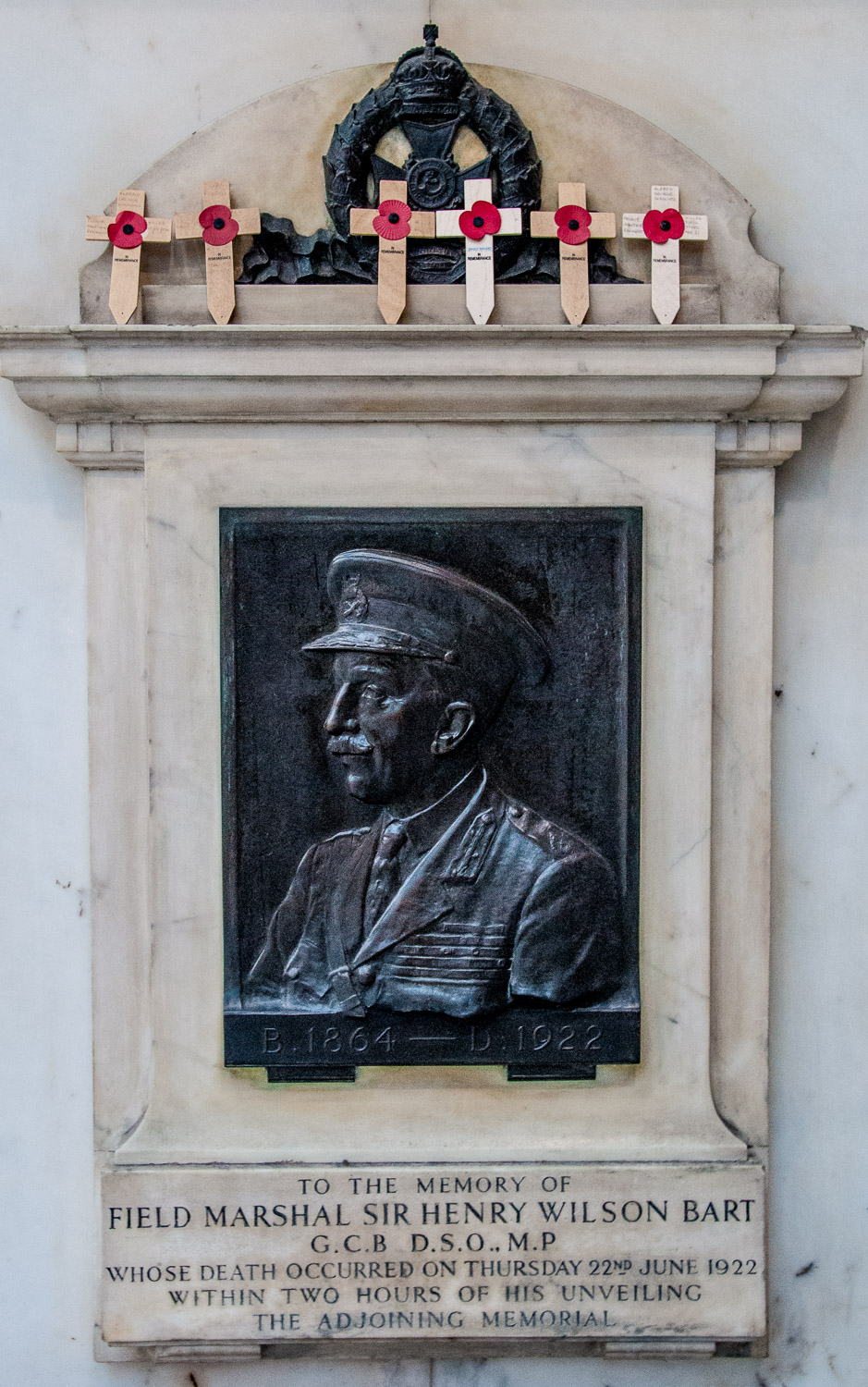
Wilson was assassinated outside his house in Eaton Place at about 2:20 pm. Still in full uniform, he was shot six times, two bullets in the chest proving fatal. The two perpetrators, IRA volunteers Reginald Dunne and Joseph O’Sullivan, shot two police officers and a chauffeur as they attempted to escape but were surrounded by a hostile crowd and arrested after a struggle. Interestingly both were former British army officers and O’Sullivan had lost a leg at Ypres, his subsequent disability hindering their escape. After a trial lasting just three hours they were convicted of murder and hanged at Wandsworth gaol on 10 August that year – justice was certainly delivered swiftly in those days. No organisation claimed responsibility for Wilson’s murder.
Until researching this event I hadn’t realised that, in all, about 210,000 Irishmen served in the British forces during World War One. Since there was no conscription, about 140,000 of these joined during the war as volunteers and about 35,000 of them died.
A brave doctor from an earlier war is commemorated in the church of St Bartholomew the Less, his actions and character described in poignant detail …
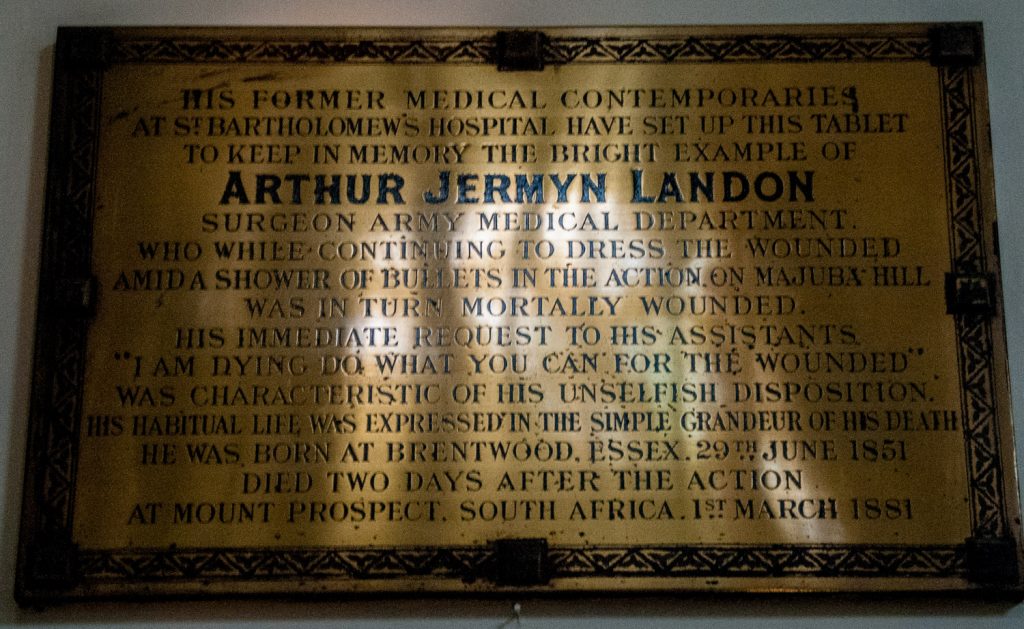
His former medical contemporaries at St Bartholomew’s Hospital have set up this tablet to keep in memory the bright example of ARTHUR JERMYN LANDON Surgeon Army Medical Department who, while continuing to dress the wounded amid a shower of bullets in the action on Majuba Hill, was in turn mortally wounded. His immediate request to his assistants “I am dying do what you can for the wounded” was characteristic of his unselfish disposition. His habitual life was expressed in the simple grandeur of his death. He was born at Brentwood Essex 29th June 1851. Died two days after the action at Mount Prospect South Africa 1st March 1881.
A plaque of a totally different nature is affixed to a hotel in Carter Lane …
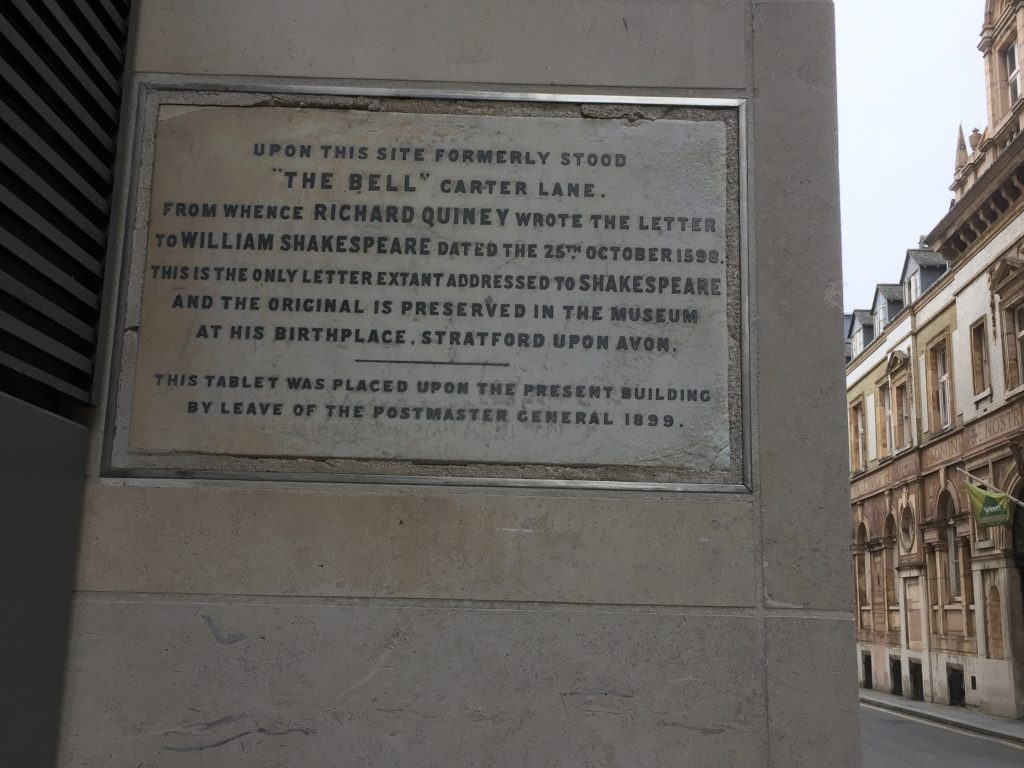
The plaque was the result of a long campaign by a City grandee called Joseph Newbon who was a great believer in making sure that historical events connected with the City were properly commemorated.
Ironically, the letter written to Shakespeare by Richard Quiney (asking to borrow £30, about £3,700 in today’s money) was never dispatched and was found among his papers after he died.
Here it is …
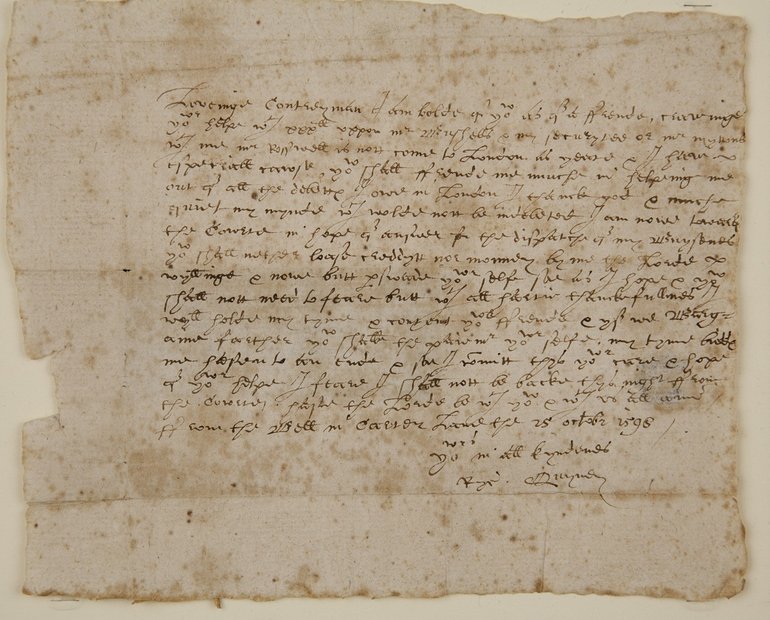
You can find a transcript here, along with a lot more information, on the Shakespeare Birthplace Trust website.
The plaque was originally on the wall of a major Post Office, hence the reference to the Postmaster General. Now demolished, its imposing entrance has been incorporated into the hotel …
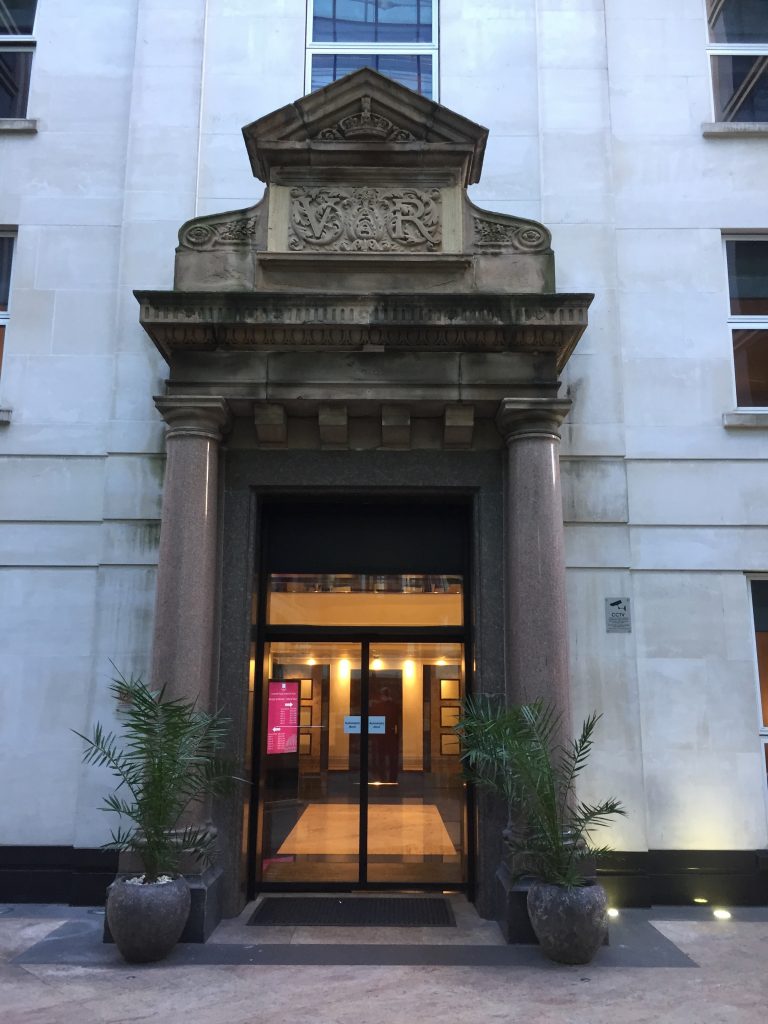
Whilst on the subject of The Bard, this magnificent bust is in St Mary Aldermanbury Garden, Love Lane EC2 …
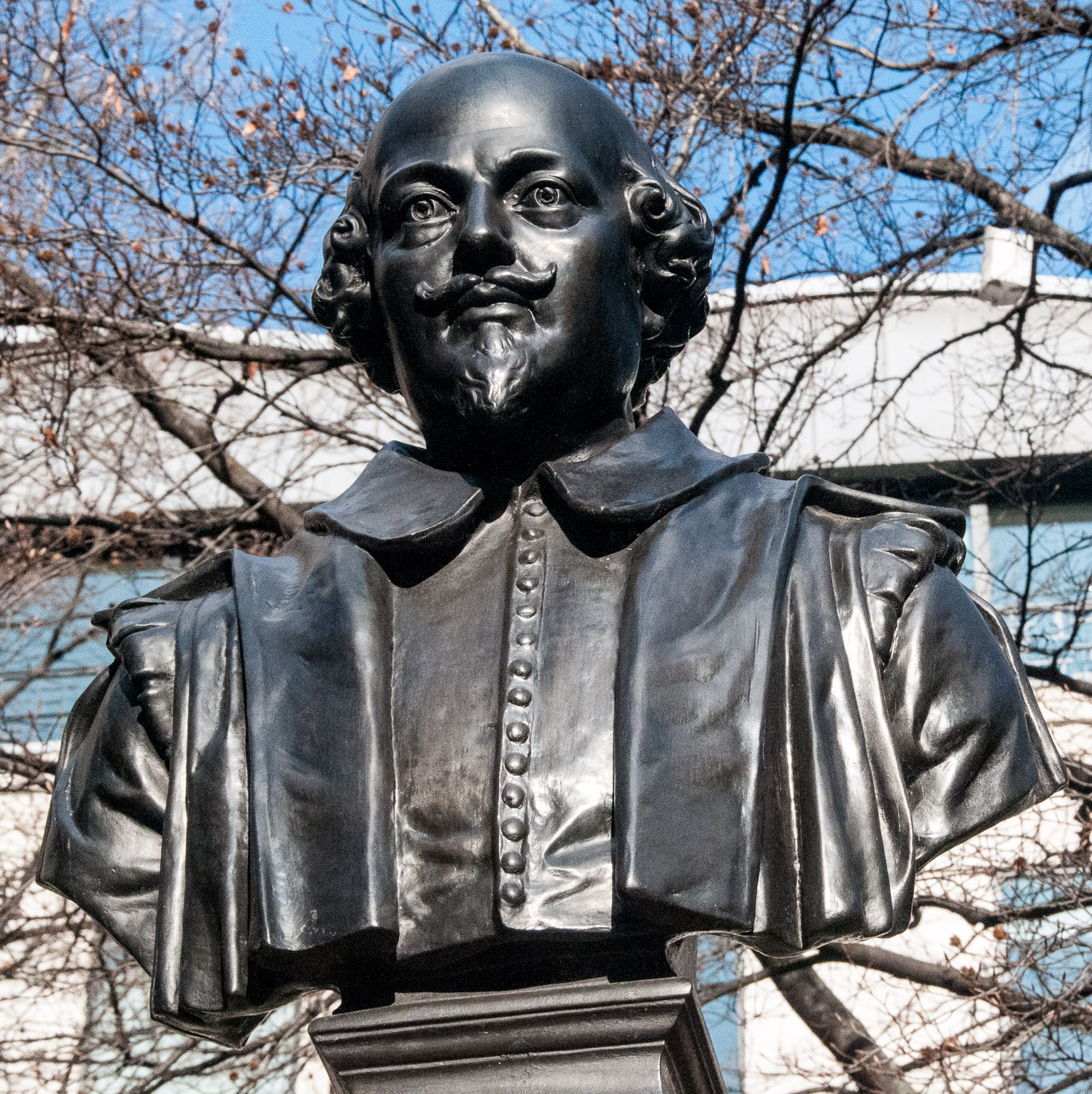
A Wren church gutted in the Blitz, the remains of St Mary Aldermanbury were shipped to Fulton, Missouri, USA in 1966. The restored church is now a memorial to Winston Churchill’s ‘Iron Curtain’ speech made at Westminster College, Fulton, in 1946.
Below the bust is a plaque commemorating his fellow actors Henry Condell and John Heminge who were key figures in the printing of the playwright’s First Folio of works seven years after his death. There are almost twenty plays by Shakespeare, including The Tempest, Julius Caesar, Macbeth and Antony and Cleopatra, which we would not have at all if it were not for their efforts. Both of them were buried at St Mary’s …
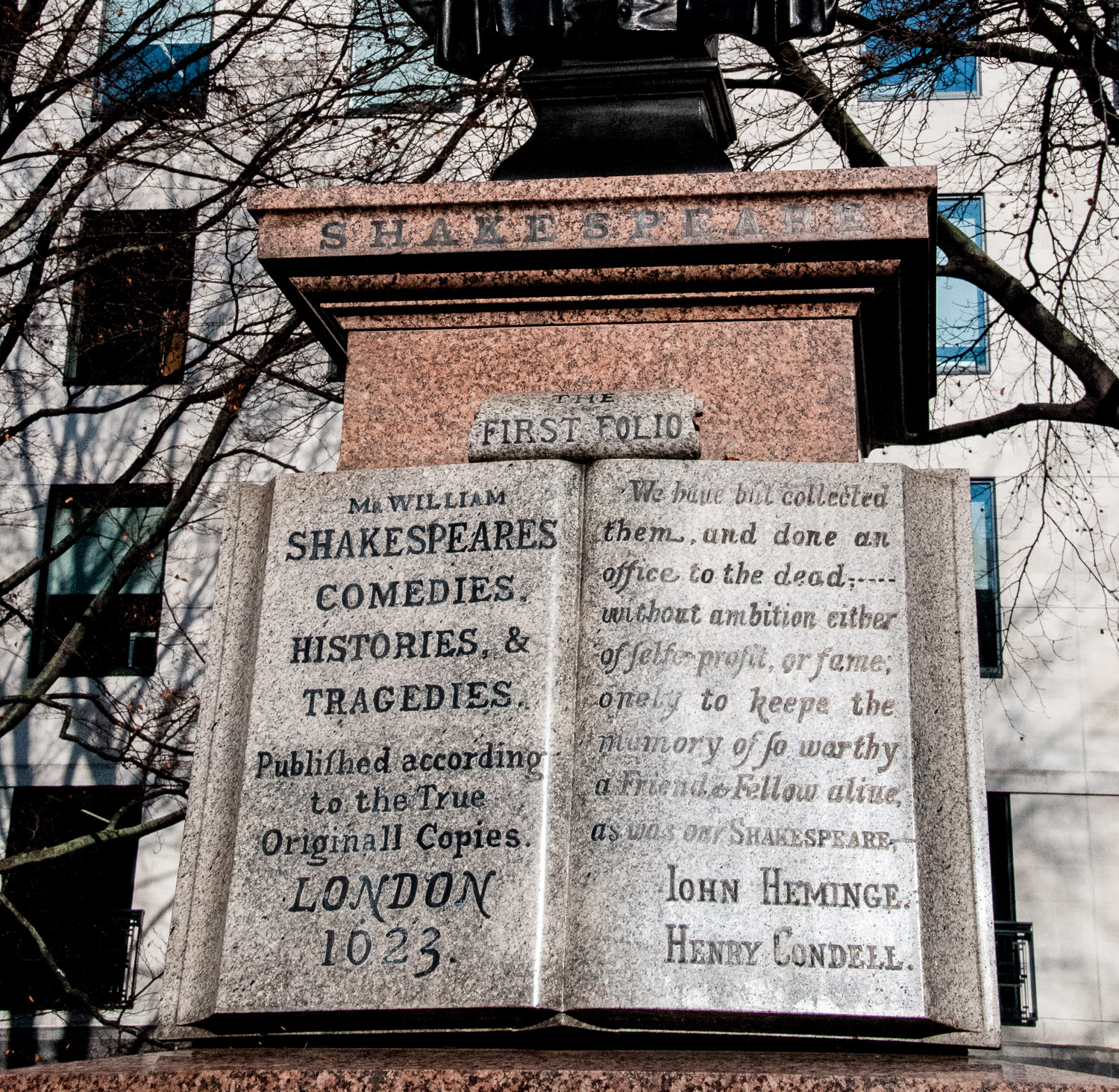
This is what Shakespeare had to say about the churchyards of his day …
‘Tis now the very witching of the night
When churchyards yawn, and hell itself breathes out
Contagion to the world.
(Hamlet’s soliloquy Act 3 Scene 2)
Up until the mid-19th century the City contained numerous churchyards, usually adjacent to a parish church, but these were becoming seriously overcrowded and seen as an obvious threat to health. Not only did the population have to breathe in the ‘odour of the dead’, gravediggers themselves could contract typhus and smallpox from handling diseased corpses.
You can get a sense of how packed the graveyards were if you look at them now and see how much higher than street level some of them still are. For example, here is the view from inside St Olave Hart Street …

Eventually the overcrowding of the dead meant relatively fresh graves were broken into while new ones were being dug, and corpses were dismembered in order to make room for more. Sites were also subject to body snatchers (nicknamed the ‘Resurrection Men’), who sold the corpses on the black market as medical cadavers. The government eventually took action action when a serious cholera epidemic broke out and burial within the City limits was virtually totally prohibited by a series Burial Acts.
The removal of the dead from one churchyard is commemorated here …
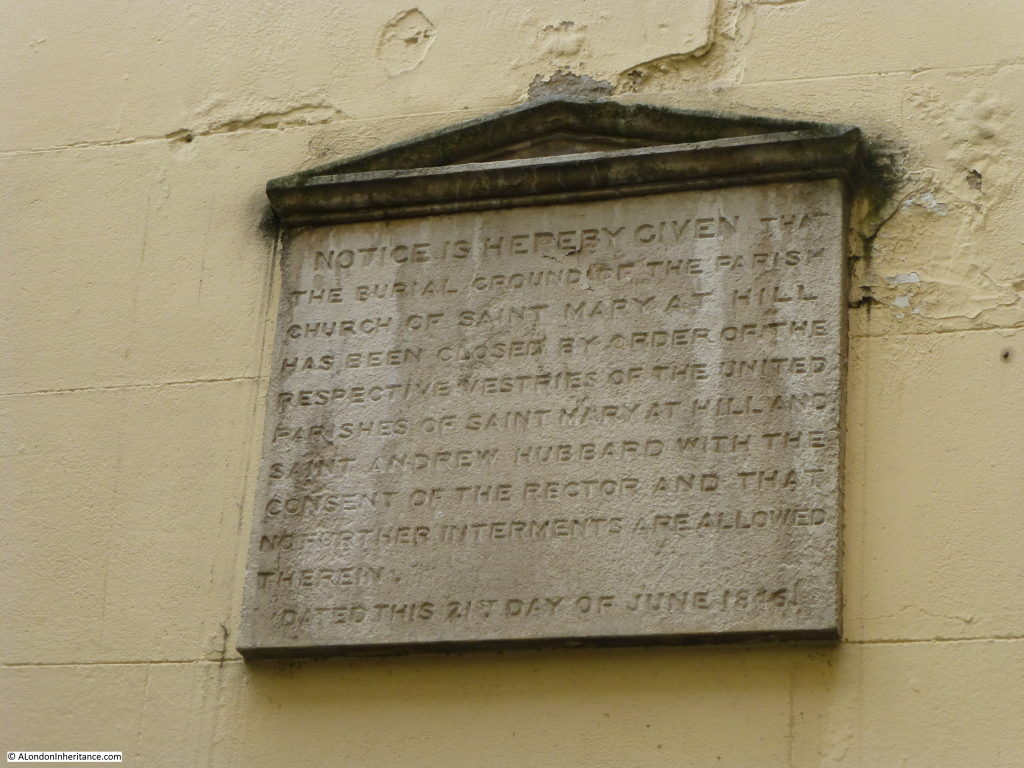
A plaque on the wall informs us that ‘the burial ground of the parish church of St. Mary-At-Hill has been closed by order of the respective vestries of the united parishes of St. Mary-At-Hill and Saint Andrew Hubbard with the consent of the rector and that no further interments are allowed therein – Dated this 21st day of June 1846’. Following the closure, all human remains from the churchyard, vaults and crypts were removed and reburied in West Norwood cemetery. You can read more on the excellent London Inheritance blog.
Some bodies remained in place only to be resited for other reasons. In the case of the churchyard of St John the Baptist upon Walbrook it was the construction of the District Line underground railway …
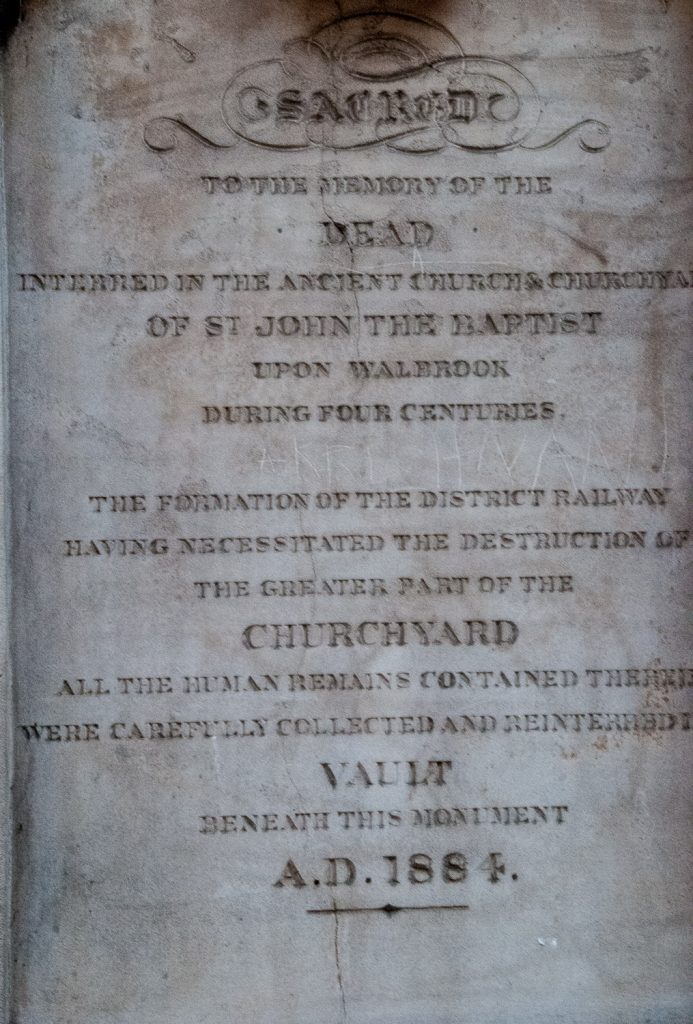
There is a fascinating article here about the London Underground’s construction and it’s reported encounters with London’s dead.
St Olave Silver Street was totally destroyed in the Great Fire of 1666 but its little churchyard lives on. A much weathered 17th century stone plaque records the terrible event …
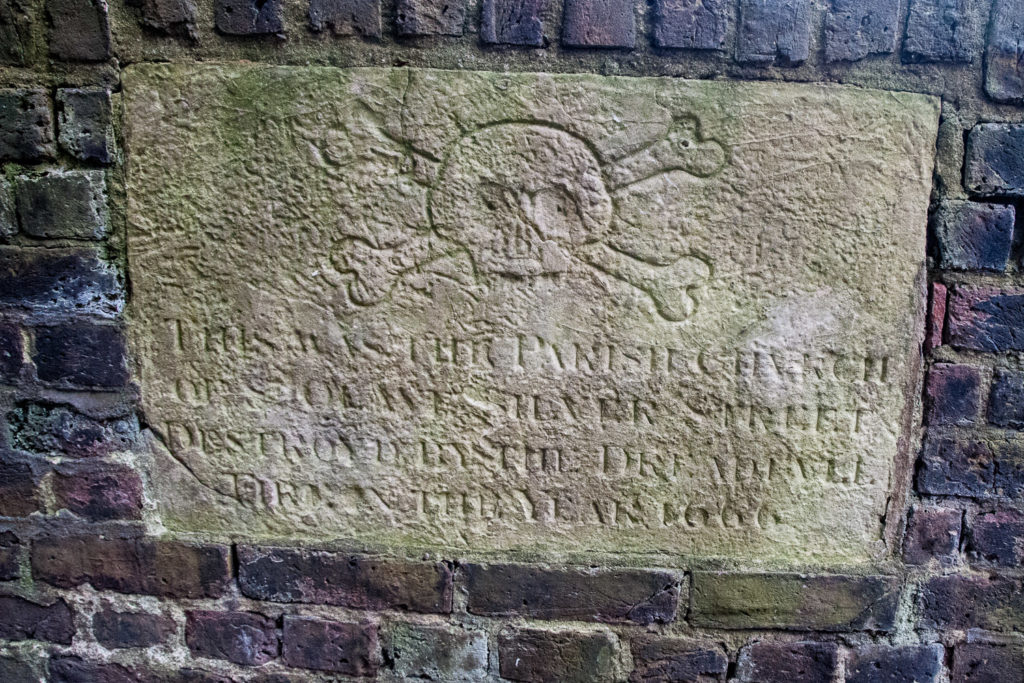
This was the Parish Church of St Olave Silver street, destroyed by the dreadful fire in the year 1666.
Silver Street itself was annihilated in the Blitz and erased completely by post-war development and traffic planning. The little garden containing the stone is on London Wall at the junction with Noble Street.
I shall end on two more lighthearted notes.
Probably hundreds of people pass through the subway that leads to Mansion House Underground Station every day and don’t notice this old plaque dating from 1913 …

It celebrates not only the opening of the subway but also some brand new Gentlemen’s toilets (hence the involvement of the Public Health Department). ‘Street fouling’ had become a major problem, hence the rather ambiguously worded signs that were once common around London exhorting people to …
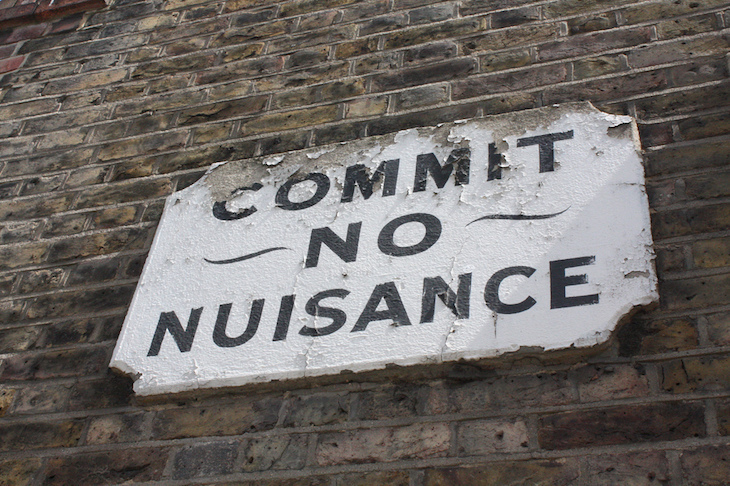
In the mid 19th century ideas were being put forward for ‘halting places’ and ‘waiting rooms’ and the City of London installed the first underground ‘Convenience’ outside the Royal Exchange in 1855. It’s still there, completely renovated, and is accessed by tunnels leading to Bank Underground Station. The original toilets were for men only, ladies had to wait another 30 years for their ‘convenience’.
The Mansion House loo is now closed and sealed off but a great example of street level toilet architecture exists on Eastcheap …
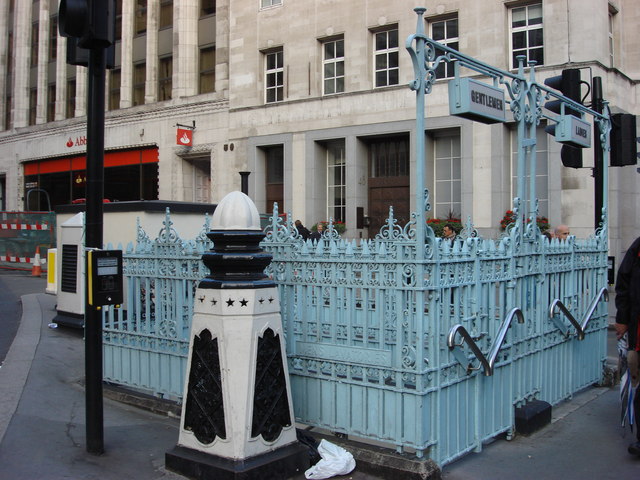
I am indebted for much of this information to a lady called Sarah McCabe who made the provision of underground conveniences the subject of her MA dissertation – I highly recommend it.
And finally. I know I have written about this famous cat before but it’s a nice story so I am going to repeat it.
High up on a tiled pillar in Barbican Underground Station is this rather sad little memorial …
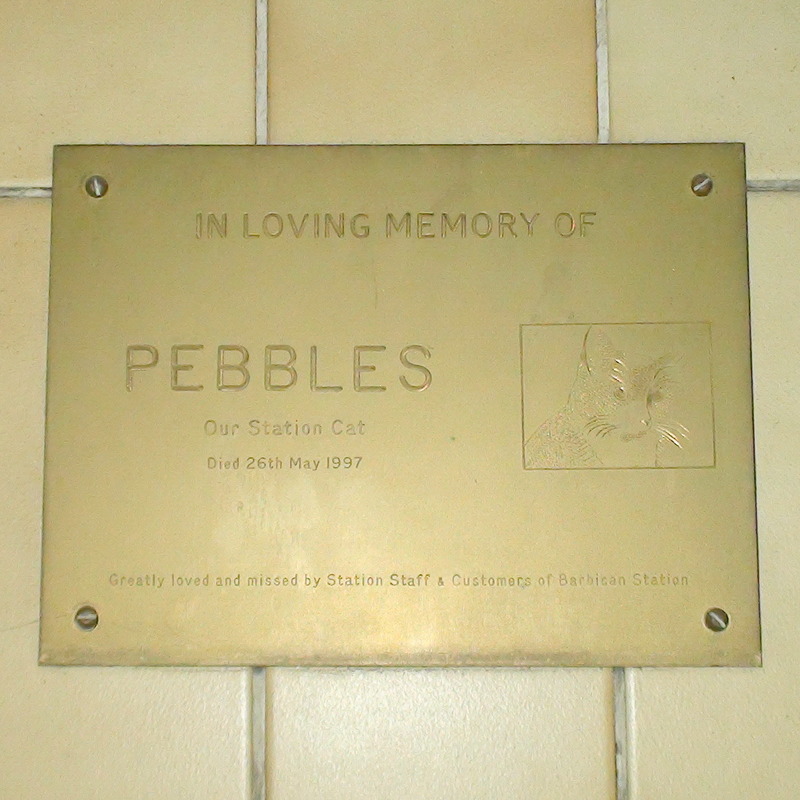
For many years Pebbles was a favourite of staff and passengers, often sleeping soundly on top of the exit barriers despite the rush hour pandemonium going on around him. Here is a picture from the wonderfully named Purr’n’Fur website, a great source for moggie-related stories …
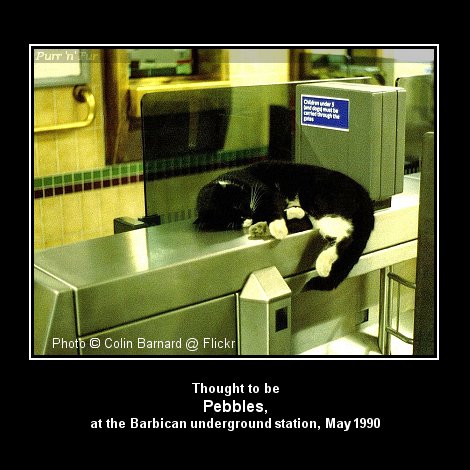
Clearly he was greatly missed when he died, as the plaque faithfully records, on 26th May 1997. This was doubly sad because he was due to be given a Lifetime Achievement Award. This was sponsored by Spillers Pet Foods and named after Arthur, a cat they used in their advertising who, I seem to remember, ate with his paws. The Certificate that came with the award is also displayed (the co-winner, the aptly named Barbie, was Pebbles’ companion) …
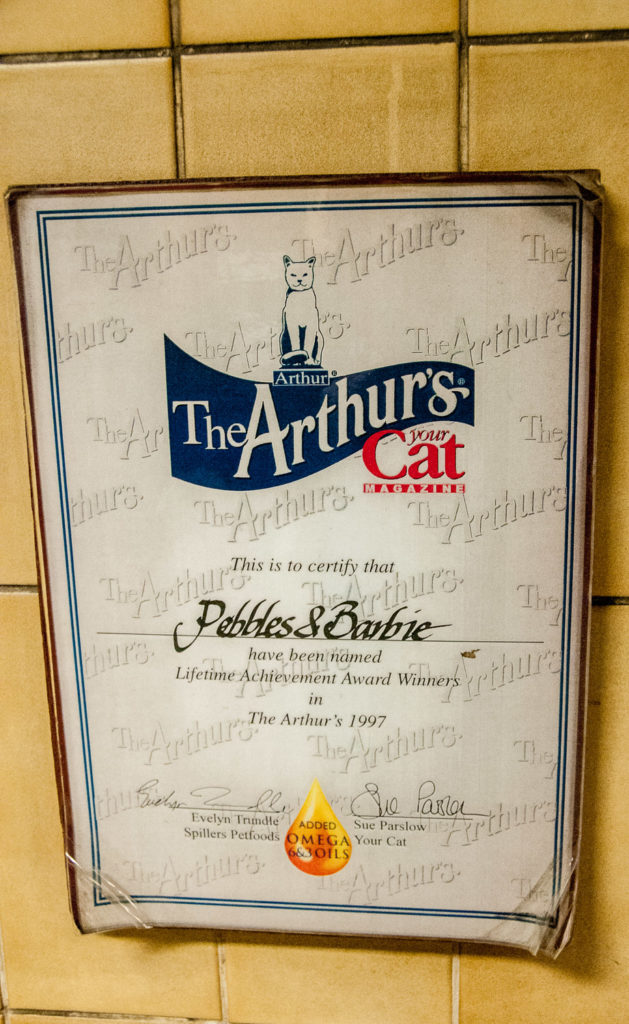
Do remember that you can follow me on Instagram :
